Chihuahua city, Chihuahua 作者: 来源: 发布时间:2021-03-22
1. Basic data
Pop.: 878,062
Area: 8,384 km2
Elev.: 1,415 masl
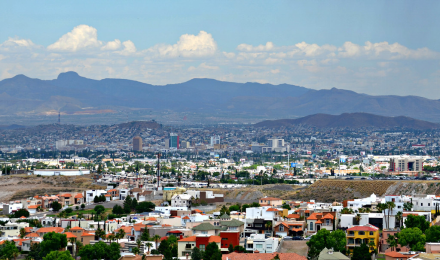
Chihuahua location in Mexico within the state of Chihuahua
https://goo.gl/maps/yAFmrnBMmHT2vr3w8
2. Natural geography
In the high plateau region and on the plains, native plants include lechuguilla (an evergreen succulent), mesquite (a common desert shrub), guayule (a rubber producing plant), and ocotillo (a succulent plant with red flowers). Native animal life includes lizards, rattlesnakes, and small birds and animals such as quail, shrews, rabbits, squirrels, skunks, wild boars, and porcupines.
In the mountains (sierras), native plants include pine and fir trees, poplars, and white cedar trees. Native animals include bats, moles, rats, bears, white-tailed deer, wolves, gray foxes, raccoons, and squirrels. There are nearly three hundred species of migratory and native birds, including spotted owls and blue-throated hummingbirds, along with over eighty species of reptiles.
https://www.nationsencyclopedia.com/Americas/Aguascalientes-M-xico/Chihuahua.html
Weather
Köppen Classification: Tropical and Subtropical Steppe Climate
steppe regions. It is transitional to the tropical wet-dry climate on the equatorward side and to the mediterranean climate on its poleward margin, with a cooler, wetter winter resulting from the higher latitude and mid-latitude frontal cyclone activity. Annual precipitation totals are greater than in tropical and subtropical desert climates. Yearly variations in amount are not as extreme as in the true deserts but are nevertheless large.
The Köppen Climate Classification subtype for this climate is "BSk". (Tropical and Subtropical Steppe Climate).
The average temperature for the year in Chihuahua is 67.0°F (19.4°C). The warmest month, on average, is June with an average temperature of 80.0°F (26.7°C). The coolest month on average is January, with an average temperature of 54.0°F (12.2°C).
The highest recorded temperature in Chihuahua is 104.0°F (40°C), which was recorded in June. The lowest recorded temperature in Chihuahua is 14.0°F (-10°C), which was recorded in December.
The average amount of precipitation for the year in Chihuahua is 17.6" (447 mm). The month with the most precipitation on average is August with 4.1" (104.1 mm) of precipitation. The month with the least precipitation on average is February with an average of 0.2" (5.1 mm). There are an average of 37.0 days of precipitation, with the most precipitation occurring in August with 7.0 days and the least precipitation occurring in March with 1.0 days.
In terms of liquid precipitation, there are an average of 58.9 days of rain, with the most rain occurring in August with 12.9 days of rain, and the least rain occurring in February with 1.7 days of rain.
https://www.weatherbase.com/weather/weather-summary.php3?s=352267&cityname=Chihuahua%2C+Chihuahua%2C+Mexico&units=
Getting there and around
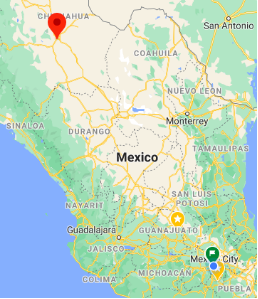
By Air – You can get to Chihuahua City by plane from Mexico City, Monterrey, Tijuana, La Paz, and destinations in the USA including Los Angeles, Houston and San Antonio. The airport is about 30 minutes drive from Chihuahua City. A taxi will take up to four people for a fixed fee; buy your tickets at the taxi desk inside the terminal building. If you want to rent a car, agencies have desks inside the main airport terminal building; booking car rental in advance will save you money in comparison to renting on the day (see car rental). For detailed information about flights and flying, see the Mexperience guide to Air Travel in Mexico.
By Bus – First class buses run all day every day from Mexico City to Chihuahua and even further north to Ciudad Juarez on Mexico-USA border. Chihuahua has excellent national bus connections and you can get from here to many places south, north, east and west. There are also regular buses from Chihuahua to destinations in the USA. For detailed information about bus transportation read the Mexperience guide to Bus Travel in Mexico.
By Car – Driving to Chihuahua City from the southern border of the United States at Ciudad Juarez will take you about 4 hours on Toll Road 45. The drive north from Mexico City will take considerably longer – around 12 hours using the faster toll roads where possible. See additional information about Driving in Mexico and Mexico’s Toll Roads on Mexperience.
Car Rental – To explore Mexico’s colonial towns and cities, consider renting a car for your visit. Having your own car will give you more flexibility than using public transport options and, in some cases, offer you access to places which are otherwise difficult to visit without the use of a car. Read our guide to Car Rental in Mexico to learn what you need to know about car rental in Mexico and connect to the Mexperience Travel Center to reserve your Rental Car.
Local Buses – Local buses are available, but most of Chihuahua City’s main attractions downtown are best experienced on foot.
Taxis – Taxis in most of Mexico’s colonial towns and cities are not metered, so agree your price before you get in. Taxi travel is very affordable in Mexico, in comparison to the USA, Canada and Europe, and so provides a viable means of public transportation in Mexico. Your hotel can arrange taxis for you; some post their rates on a board in the lobby; taxi hotel rates are usually higher than cabs you hail off the street. If you speak Spanish, you will have a distinct advantage and be able to negotiate a price with the driver. For detailed information, read the Mexperience guide to Taxi Travel in Mexico.
Uber is available in Chihuahua.
3. GDP: 165,948 M MXN
4. Industry
Among cities in Mexico, the city of Chihuahua is highly ranked in human and social development. According to the UNCP report on human development, Chihuahua municipality's HDI is 0.840 as of 2015 – this is equal or higher than some Western European countries, together the literacy rate in the city is among the highest in the country at 99%. Another report about competitiveness from the CIDE organization ranks Chihuahua as the second most competitive city in the country just behind Monterrey and ahead of Mexico City. This report also ranks Chihuahua as the most Socially Competitive city in the country.
Chihuahua is the twelfth largest city in Mexico, and one of the most industrialized. Manufacturing is very important and there are nine major industrial parks and 79 maquila manufacturing plants, which employ about 45,000 people. The city serves as an alternative destination for maquiladora operators who require quick access to the border but wish to avoid both the higher costs and higher turnover rates of employment of the immediate border area. Of all interior (non-border) locations in Mexico, Chihuahua has the largest maquiladora presence in Mexico. Some of the larger companies include Ford Motor Co., Sumitomo Electrical, Honeywell, Hallmark, and LG Electronics.
The city's most important feature is its collection of industrial zones, in which foreign companies have manufacturing facilities, called maquiladoras, which employ thousands of people. This light industry also requires professionals, both for manufacturing and for management; this training is provided by universities such as the Universidád Autónoma de Chihuahua,[20] the Instituto Tecnológico de Chihuahua and Instituto Tecnológico de Chihuahua II. A number of private universities also exist, to include the Chihuahua campus of ITESM.
The city's commercial sector has also been boosted by the growth of the middle-class. The wages paid by industries to management and high-level technical employees provide a cash flow unlike that of most Mexican cities.
The entire state of Chihuahua is also a thriving economic center. Chihuahua's annual Gross State Product (GSP) is about $6.2 billion. There are more than 350 established manufacturing and assembly plants in the state; manufacturing accounts for a third of the total GSP, while trade and other services amount to 53.5%. Chihuahua has the largest amount of forested land in all of Mexico. Forty-four percent of Chihuahua's workers are employed in commerce and services, while a little over a third of the workforce is employed in mining and industry. In mining, Chihuahua state is the leading producer in the republic of non-ferrous minerals and zinc, and is second nationwide in silver extraction. Agricultural production makes up only 6% of the total GSP, however the state is the leading producer of apples, nuts, cattle and sheep raising nationally, and second in pine and oak trees harvested.

Evolution of Chihuahua City’s PIB (millions of MXN)
http://www.municipiochihuahua.gob.mx/Downloads/PMD%202018-2021.pdf
5. Touristic sites
Colonial Downtown
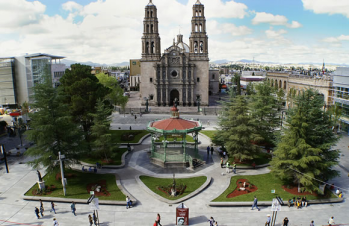
The city’s Cathedral overlooks the busy Plaza de Armas (main Plaza) where small band-stand like structures host a series of shoe shiners busy polishing the shoes and cowboy boots that can be seen everywhere here; Chihuahua has a lot of ranches on its outskirts. This is Mexico’s cowboy country.
Two imposing buildings greet you at the end of Calle Libertad, a pedestrianized area of shops: The Federal Palace; a fine looking building inside and out that today houses Chihuahua’s main postal and telegraph offices; on the left of it, the back of the Government Palace. Around the corner is Plaza Hidalgo, where a statue commemorating Padre Miguel Hidalgo, one of the fathers of Mexico’s independence movement, stands proudly in the center. The main entrance to the Government Palace is off here.
The Government Palace is built in the traditional style with an impressive courtyard surrounded by a series of passageways and rooms; today they are all official government offices. All three levels of the building have public access, and there are fine murals on most of the walls which depict Mexico’s struggle for independence. The Palace is one of the finest in Mexico; it takes a good couple of hours to see the building properly.
Paseo de Simón Bolivar (Simón Bolivar was a Venezuelan who led the independence movement in South America) – is a picturesque avenue lined with old colonial villas and mansions and a nice park where families gather to play, eat, drink and relax.
Museo Casa Juárez
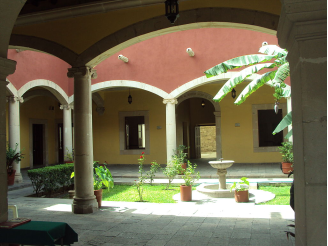
The Museo de la Lealtad Republicana (Museum of the Republican Loyalty), also known as the Museo Casa Juárez, is a 19th-century building in the city centre of Chihuahua, Mexico. It housed the constitutional government of President Benito Juárez during his stay in Chihuahua while Maximilian of Habsburg reigned as Emperor of Mexico, supported by the French, and was thus the de facto National Palace of Mexico.
In 1826 the location was purchased by the state government to serve as the Palace of Government, a role it fulfilled until the new palace was inaugurated in 1892. On October 12, 1864, President Benito Juárez, fleeing from the French invasion, arrived in the city where he established his government-in-exile.
Juárez lived in and ran the constitutional government from the palace through December 1866. He left Chihuahua when the French forces and the Second Mexican Empire had been almost totally defeated. After that the building reverted to being the Government Palace for the state administration. However, when the new palace was constructed a few blocks away, the Casa Juárez was turned into an educational institution, first as the Escuela Municipal Nro 3 for girls, redesignated as Escuela Oficial Nro 140, and then renamed Escuela Benito Juárez, a name it retained from 1926 to 1967, when it was closed.
In 1972, during the observance of the centenary of the death of Benito Juárez, the authorities decided to turn the building into a museum. Many objects and furniture original to the house had been lost long since; however, the state government was, during the years-long planning stage, able to recover original furnishings as well as period pieces similar to those that Juárez had used.
In 2000 the restoration was complete and the renamed Museo de la Lealtad Republicana was opened to the public.
https://www.mexicoescultura.com/recinto/55034/museo-de-la-lealtad-republicana-casa-de-juarez.html
Metropolitan Cathedral
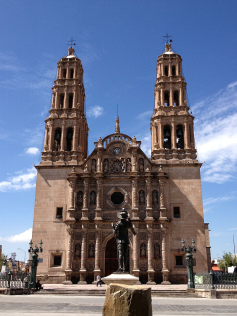
The Metropolitan Cathedral Church of the Holy Cross, Our Lady of Regla, and St Francis of Assisi is the main ecclesiastical building of the Catholic Church in Chihuahua City, Chihuahua, Mexico. It is considered perhaps the finest example of colonial architecture in northern Mexico and it was built between 1725-1792. The cathedral is also the seat of the Roman Catholic Archdiocese of Chihuahua. As of 2013 the archbishop was Constancio Miranda Weckmann.
The first stone was placed on 21 June 1725 by the Bishop of Nueva Vizcaya in Durango, Don Benito Crespo y Monroy (in those times, Chihuahua depended religiously upon, and was a part of, the Diocese of Durango.) The church was paid for with local commercial donations and by mine owners in the city and in Santa Eulalia, a pueblo to the east, and also by a tax of one real on each mark of silver that was mined in the province.
Chihuahua, Chihuahua, Mexico - Is Mexico Dangerous? What Mexico looks like in the North!
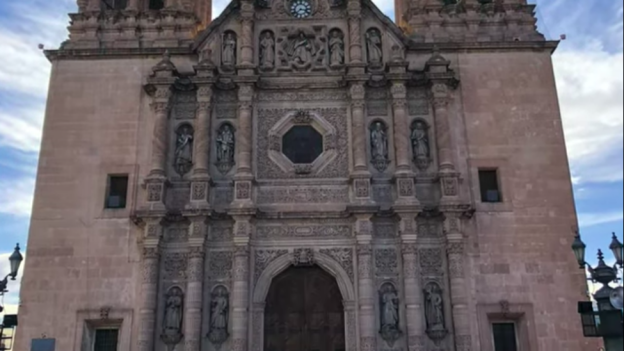
https://youtu.be/3Q-j2wZbHjg
6. History and Culture
Foundation
The origin of the city of Chihuahua begins with the discovery of the nearby mines and foundation of the population of Santa Eulalia in 1652 by Spanish captain Diego del Castillo, however; due to the climate and constant attacks of the indigenous people the exploitation was suspended and Santa Eulalia remained several years uninhabited. Some fifty years later, in 1707, more wealthy mining discoveries were made, leading to the immediate population of Santa Eulalia and its prosperity.
However, Santa Eulalia is located in the middle of a mountain range and the difficult terrain hindered the construction and expansion of the city; because of this, when in 1709 the governor of Nueva Vizcaya, Antonio de Deza y Ulloa, with the instruction to found the head of the Real de Minas visited the population, decided to convene 16 notable neighbors (miners, traders, government officials and priests) to resolve with them the desirability of setting up Santa Eulalia herself at the head of the Royal de Minas or founding for them a new population in the nearby valley where the rivers converged Rio Chuvíscar' Chuvíscar and Sacramento.
On 12 October 1709 the vote of the notables was held on the founding of the Royal de Minas, eight of them were manifested because they were it was located in Santa Eulalia itself, while the remaining eight did so for the foundation in the valley. Faced with the tie, the governor Deza and Ulloa intervened with his vote of quality by demonstrating for the foundation of the population in the valley of the junta de los ríos; this is what is seen as the official foundation of Chihuahua and Antonio Deza and Ulloa as its founder. The new Real de Minas was founded under the name of Real de Minas de San Francisco de Cuéllar in honor of the then Viceroy of New Spain, Francisco Fernández de la Cueva Enríquez, 10th. Duke of Alburquerque and Marquis de Cuéllar.
Spanish Colony
The growth of the Real de Minas, driven by mines and activity of the surrounding farms continued during the colony; because of this on October 1, 1718, it stands at the Royal of San Francisco de Cuéllar in Villa, with the name of San Felipe el Real de Chihuahua'; Saint Philip in honor of the king Felipe V of Spain and being used for the first time the name of Chihuahua. At this time it is also solved the construction of a parish temple worthy for the village, to that end, the city council decided to impose a special tax on silver extracted from the mines of Santa Eulalia and with it was built the temple that today is the Catedra Scun. By the year 1786 the Villa de Chihuahua was a Mayor's and on April 1, 1797 the first census was lifted in the city of Chihuahua by Don Fructuoso Simón de Herrera with the following summary: 324 men, 396 women, total 720 inhabitants.
In the 18th century, an aqueduct with quarry arches pouring water into a fountain in the main square was built in the city. Then elegant houses appeared, some with wooden floors worked with rich woods brought from the mountains; these houses had orchards with fruit trees and vegetables, chicken coops and smaller cattle. Wealthy miners like the Irigoyen and Carbonel decorated their mansions with luxurious furniture, magnificent paintings, silverware and beautiful porcelain. In the name of the king of Spain came the "visitors" to investigate the morality and justice of the kingdoms and to collect taxes. They read heralds through the streets, which enacted good treatment of indigenous people; Despite this they were confined and restricted by their freedom, always being under the rule of the Spaniards, Creoles and mestizos. With this mixture of races he was writing, over the centuries, the history of the capital. As in other parts of northern Mexico, the peregrinos Catholicism greatly influenced the colonial era, and the city became a meeting point for pilgrims on their way to "La Sierra", a mountainous region in which the indigenous people had not yet converted to Catholicism.
Also built in the city was a College run by the Society of Jesus, which built a solid building on the east end of the village, later and after the expulsion of the Jesuits, the school building was used as a barracks, prison and mint.
Independence
The information on the beginning of the Independence of Mexico movement took a long time to reach the then Villa de Chihuahua, where in practice it had no effect, because of this The Realists decided that the trial of the insurgents apprehended in Acatita de Baján will be held in Chihuahua. On April 23 the prisoners entered Chihuahua to be tried and on June 26 the insurgents Ignacio Allende, Mariano Jiménez, Juan Aldama and Manuel Santamaría are shot in the convent of San Francisco. On 30 July, don Miguel Hidalgo y Costilla was shot in the courtyards of the military hospital, a place formerly the convent of Loreto. During the rest of the war of independence the situation in Chihuahua was practically identical and without any shock.
Once independence was consummated through the Treaties of Cordoba, and after the ephemeral First Mexican Empire, on 19 July 1823 the Union Congress issued a decree dividing the former province of the New Biscay in two, the Province of Durango and the Province of Chihuahua, and pointed by capital of the latter to the Villa of San Felipe el Real de Chihuahua, which from that moment was erected in city, and was called Chihuahua'.
Post-Independent time
During the American Intervention War, Chihuahua was occupied by a column of the U.S. Army under Alexander Doniphan, who came from [New Mexico], had previously occupied Santa Fe and El Paso. For the defense of Chihuahua, the Battle of Sacramento, on February 28, 1847, was enlisted with the invaders, with the full defeat of Mexican forces dispersed, the state government moved to Parral and March 1 the U.S. military occupied the city. On March 7, 1848, the second occupation of the Anglo-Americans occurred and Governor Trías evacuated Chihuahua and was occupied by the invading chief Sterling Price. This situation lasted until 25 July, when the capital was evicted by the invaders. The legitimate authorities reinsettled in their official residence on 14 August of the same year.
La Reforma
On January 4, 1858, within the War of Reformation, which generally dominated the liberal party with the exception of two short seasons in which the conservatives occupied the capital by armed hands, Lieutenant Colonel Bruno Arriada and Mr. Juan N. Bárcenas seduced the garrison forces, proclaimed the Tacubaya Plan and set a half-hour deadline for the governor, Mr. Antonio Ochoa, to sign his accession. He retired to Aldama, gathered the national guard under the command of Colonel José Esteban crowned and the next 19 recaptured the capital.
On May 5, 1862, Don Mariano Sáenz built at his expense the first building specifically intended for theater, was called "Teatro de Zaragoza", was located in the street of La Libertad, near the current Plaza de Merino and premiered with the play "Los French in Mexico." On September 15, 1877, it was inaugurated by the governor of the state, General Angel Trías the "Teatro Betancourt", located in the street of La Libertad, built by the Jalisciense Don Miguel Betancourt, who was located in Chihuahua for more than twenty years. With a celebration of the "Scream of Independence", it lasted until May 27, 1904 when it was destroyed by fire. The "Coronado Theatre" opens, which was in ojinaga street and also disappeared from a fire. Mr. Betancourt built it. On 12 October 1864, the head of the Federal Executive Power, Mr. Benito Juárez, arrived in the city on the occasion of the events of the French intervention and the empire. He was accompanied by his Secretaries of State, dispatched to the official residence of the state government. It remained until August 5, 1865, when it took the northern way; returned to the capital on 20 November and returned to the border on 9 December. The last season remained in Chihuahua from 17 June to 10 December 1866. At this time the 3 ships that overlook the now Victoria Street, part of the Municipal Palace, were sold to support the expenses demanded by the movement of troops on the occasion of the departure of President Juárez and his Ministers in the direction of Paso del Norte.
At the time of the Reformation it was in fact, for two years, capital of the Republic and seat of the Federal Powers, as the former Government Palace, today Museo Casa Juárez, became from 1864 to 1866, the National Palace and the residence of President Benito Juáre z and their ministers.
On March 25, 1866, a battle was set in the Plaza de Armas, the French imperialists were quartered in the Cathedral and General Terrazas was moving through Victoria and Independence streets, it was practically impossible to enter the cathedral, until it was decided that it would be cannoned and from Coronado and Ocampo streets they did, the 8 kg bullet. weight fell just in the bell breaking it in half, after this fact the French went out to surrender and recovered the city. The bell was declared by the city hall historical monument and still today can be seen inside Cathedral.
Porfirian era
In 1875, the images began to be reproduced on paper or cardboard, based on the daguerreotype, and because in 1863 the Anglo-American Henry W. Barquer was established and on March 2, 1876 the telegraph was inaugurated in the short stretch between the government house (J street) not uarez. 321) and the stage station called "La Despedida" (Bolívar and 10a walk) On April 23, the service between Chihuahua and Rosales was inaugurated and in August 1877 with Mexico City. The city's first telegraphist was named Francisco Hernández.
On June 2, 1876, Colonel Angel Trías rebelled in favor of the Tuxtepec Plan, seize the capital and take the constitutional governor, Lic. Antonio Ochoa, prisoner. The term-appointed surrogate, Manuel de Herrera, dispatched successively in Cusihuiriachi, Guerrero and Camargo, raised the national guard and joined the government troops. Defeated by the Porphyrists at the Avalos ranch on 19 September, the legitimate authorities resumed the exercise of their duties in the capital.
On February 6, 1877, General Juan B. Camaño, at the head of a Tuxtepecana brigade, occupied the capital, deposed the constitutional authorities, assumed the political and military command of the state and began the new era.
On May 5, 1881, the first telephone line was inaugurated by Félix Francisco Maceyra, manager of Banco Mexicano. This line was between the bank offices, corner of Independencia Avenue and Victoria Street and the address of the mint, located where the Federal Palace is located. Three years later there were a hundred and fifty urban service aircraft and the long-distance aircraft began operating on 1 April 1930. On March 24, 1883, the first telephone communication of two populations was established, were Chihuahua and Aldama. In 1884, the Chihuahua telephone company was founded.
In 1882, as governor, General Luis Terrazas, the installation of the metal pipe was started, which gradually spread and branched. Auxiliary lime and singing ditches and piles and fountains were disappearing from the city grounds. On September 16, 1882, the first section of the railway line, from Juárez to Chihuahua, built by Ferrocarril Central Mexicano, was inaugurated, which since 1909 belonged to the system of the National Railways of Mexico. On March 8, 1884, communication was opened to Mexico City and on the 23rd passenger and freight trains began to run.
In 1883, the first typewriters were established by the main commercial houses. They began to be used in public offices in 1891, during the local administration of Colonel Lauro Carrillo.
At the end of 1884, the first line of urban trams was inaugurated between Plaza de la Constitución and the primitive station of the National Railways. They moved by shooting beasts, then, in August 1908, they moved with electric force. They disappeared in early 1922.
On September 11, 1891, the Government Palace of Chihuahua was completed by Governor Carrillo. However, the official inauguration was on 1 June 1892 by the same governor. The report published by the Directorate General of Statistics gave the city of Chihuahua, in 1895, the number of 19,520 people. At the end of the 19th century, Tomás Alva Edison's phonographs arrived in the city, which had numerous extension lines and had to be applied to people's ears to perceive sound reproductions. In the second half of 1902, the first car arrived in the city of Chihuahua, brought by Don Mauricio Calderón, and the second was introduced by Colonel Miguel Ahumada, governor of the state.
In the early years of the twentieth century, in Chihuahua there was more foreign investment in non-railway enterprises than in any other region of the country, which allowed foreigners to infiltrate at all levels of local social and economic. The population growth of the city creates the need to look for new sources to provide it with water and on September 16, 1908, the Chuvíscar dam was inaugurated, with a capacity of five million cubic meters of water, the cost was one million pesos. The preliminary study of Ing. Aguilar was taken advantage of, the final project and specifications were entrusted to the Ing. Manual Marroquín and Rivera and the construction was contracted with engineers Sheperd and Mac Quatters. From this year the landscape of industrial boom began to blur, presenting the first signs of the economic and social crisis that was exacerbated in 1910, on the occasion of the first revolutionary outbursts. In 1911, the city was held by the "rises" under the command of Pascual Orozco.
Mexican Revolution
During the stage of the Revolution, Chihuahua was the scene of the wood movement and, later, the development of Constitutionalism and Villismo, highlighting the heroic figures of Praxedis G. Guerrero, Abraham González, Toribio Ortega, Pascual Orozco, Francisco Villa and many others.
On 30 and 31 October 1911, the President-elect of the Republic. Francisco I. Madero, visits for the second time the city, having made the trip expressly to invite the Chihuahuenses revolutionary chiefs Abraham González, Pascual Orozco, José de la Luz Blanco, José de la Luz Soto, Máximo Castillo and others, to accompany at the event of their protest as the holder of the Federal Executive.
The constitutional reform of October 28, 1911 abolished political headquarters in the state and created the free municipality. This provision began to govern from 1 January 1912, and since then, each municipality is administered by a popularly elected municipality, without any dependence on the others, whose presidents are directly understood with the governor of the state, there should be no intermediate authority among them.
On December 8, 1913, Francisco Villa arrived at the place, accepting the appointment of Provisional Governor of the State, which granted him a Board of Generals; in its new role, on the 12th of the same month, it decreed the creation of the Bank of the State of Chihuahua, with guarantee of the properties confiscated from the enemies of the revolutionary cause and empowered to issue banknotes, it would close definitively in 1915. The state capital was the center of operations of the Northern Division. On April 13, 1914, Don Venustiano Carranza arrived in the city of Chihuahua, from Juarez, during his crusade against the military dictatorship of General Victoriano Huerta. He was enthusiastically welcomed by the Chihuahua people, whom he greeted from the central balcony of the Government Palace announcing the social reforms demanded by the revolution and was housed in the Fifth Gameros. The next day he received the report of the governor of the state, General Manuel Chao, on the state of the public administration and the following March 3 he moved to the city of Torreón.
In 1914, General Francisco Villa had a radiotelegraph station set up in the city of Chihuahua, which was the first to work. The facilities were made in the Municipal Palace and the antennae were placed in the towers of the cathedral.
At the end of January 1915, General Francisco Villa, supreme head of military operations, was incommunicado with the convention government, which had had to withdraw from Mexico City towards Cuernavaca. For this reason, the expressed general issued a decree authorizing himself to assume the management of public business in the territory dominated by his forces and created three departments of state for their attention, namely the Relationships Ministry, Government and Communications, and Treasury and Development. Through these departments General Villa executed all the acts of a head of state until the end of 1915. At the end of 1915, the villist regime in the capital ended. 'Revolutionary's From 1920 onwards the reconstruction of the economy began, re-emerging some important factories of the porphyriate era that had closed on the occasion of the revolution. Such was the case for the brewing industry, foundries, flours and textiles, where machinery driven by steam, electric power or gasoline was worked on, which continued with an advanced technological level.
The districts continued to be maintained but exclusively as districts with judicial functions, in October 1921 the Iturbide district changed its name to aragon
In December 1923, the first radio-telephone station was installed that operated in the city, by agreement of the governor of the state, General Ignacio C. Enríquez and had the official record "XICE". At the same time, radio-receiver devices, which were popularly referred to as "radiolas", began to be installed in homes. On November 1, 1929, the first vitáfono or spoken cinema in the "Alcázar cinema" was adapted to the cinematographer, was with the film "The Jazz Singer". In early 1931, the first lines of urban and semi-urban trucks began to circulate through the streets of the city. At this time the city had 45,595 inhabitants.
On June 21, 1941, the Palace of Government, this fire begins in the General Archive of the Executive Branch at 1 p.m. on Saturday and the Municipal Palace became the official residence of the supreme Legislative and Executive powers, until September 15, 1944 when they went back to their own building.
In 1946, the Reforma Market was set on fire, during the municipal administration presided over by Mr. Alberto de la Peña Borja. As president, Esteban Uranga built another market building, with the same title and farther from the city center. On September 26, 1947, the sports city was inaugurated by the President of the Republic, Mr. Miguel Alemán, being governor of the state, Dr. Fernando Foglio Miramontes; at the time it had a stadium with capacity for eight thousand people, monumental gym, eight pediments, tennis courts, basketball, volleyball, park and baseball stands, Olympic pool, an artificial forest of ten and seven thousand trees, electrification for night service in all sports sections and transformers in the baseball field, sports court for athletic events, boxing fields, dressing rooms, toilets, etc. Except for mining, industrial activity had not been a substance in the local economy, but from 1947, with the opening of Cementos de Chihuahua, a significant change was initiated in the industry, which was accentuated in 1960 with the establishment of maquiladoras export in the cities of Juarez and Tijuana first, and then in Chihuahua. 47 floors are installed with 24,500 workers, especially women. On November 9, 1947, the Government Palace by the then President of the Republic, Mr. Miguel Alemán. The Instituto Tecnológico de Chihuahua, known as ITCH, was the first technology institute in Mexico. The first stone was laid on September 26, 1948 by the Secretary of Public Education, Mr. Manuel Guel Vidal and by the constitutional governor of the State of Chihuahua, Mr. Fernando Foglio Miramontes.
Contemporary history
In 1956, television was installed in the city, with the foundation of XERA-TV by Telesistema Mexicano. In 1960, the construction of the Chihuahua Dam was completed, which would contribute to the supply of water and prevent flooding in a large area of the city. This year there are 150,430 inhabitants. On April 5, 1964, a banishes in the Plaza de Armas, following an act by the PRI candidate for the presidency of the republic, Gustavo Díaz Ordaz, which ends in the burning of the temple by protesters. On October 18, 1968, the University of Chihuahua was granted full autonomy. Earlier this year, XHCH-TV channel 2 is installed, the first television station to be totally local. In coordination with the private initiative, through the newly created Economic Development of Chihuahua, A.D., on September 12, 1980, the state government created the promoter of the Chihuahuense Industry that immediately proceeds to the construction of the Complex Industrial Chihuahua with the Ford plant as an anchor industry; which would subsequently attract new foreign investment and strengthen confidence to establish itself in the region. On the afternoon of July 27, 1981, Aeromexico's DC-9 "Yucatan" aircraft, covering regular flight 230 between Monterrey and Tijuana, went off the runway when landing at Chihuahua airport, for the force of wind and rain. As a result, the aircraft broke and caught fire causing the greatest misgiving in the history of state aviation; 32 passengers arrived alive, but another 32 died.
In September 1981, it was inaugurated by Mr. José López portillo, President of the Republic, the Palace of Justice of the State. On July 6, 1983, for the first time the National Action Party, with Luis H. Alvarez, won the elections for the Chihuahua City Council. It is in this year that the state is in the crosshairs of the whole country. From this moment Chihuahua became the obligatory reference for elections in the other northern states and then the entire republic. By 1984, the metropolitan area of the city of Chihuahua had 29 maquiladora plants in the Las Américas Industrial Park, of which those dedicated to the production of electrical and electronic components for export stood out.
In 1986, the year of the hot summer in Chihuahua, due to state, municipal and deputies elections that were lived. The interference of the Catholic Church in political activity as in 1983 caused the spirits to be increased and the Chihuahuanian families divided. The bishop was Don Adalberto Almeida and Merino and threatened not to officiate Mass due to the alleged electoral fraud. On December 27, 1988, the Pope appointed Archbishop José Fernández Arteaga, Coadjutor Archbishop of Chihuahua with the right to succession. He took office on 25 January 1989, and in April of that year most diocesan and religious priests sent the Pope a letter of support to Don Adalberto on the occasion of his 20 years of bishop in Chihuahua. On May 24, 1988, the city of Chihuahua was about to experience a catastrophe of incalculable dimensions when, at 10:10 a.m., the No. 14 tank of the Pemex Plant, which contained more than four million liters of diaphanous, was burned and kept on fire or for more than eight hours, with flames reaching more than 50 meters in height and at 50 meters was a similar tank containing Nova gasoline. About 200,000 people living in ten surrounding colonies were evacuated and the area was cordoned off by the Army and police forces. The fire was stifled shortly after six o't, thanks to the coordinated action of the firefighters of Chihuahua, Delicias, Camargo, Parral, Cuauhtémoc, Aldama and Ciudad Juárez. In 1990, construction began on the Children's Complex called Chihuahua 2000, which houses nearly 10,000 families. In 1998, construction began on the new UACh campus north of the city. By 2008, the South Sports Is inaugurated, in the area of Avalos.
7. Contact Information
City Mayor: María Eugenia Campos Galván
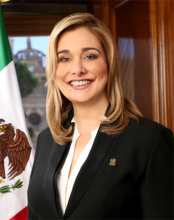
Contact number: +52 (614) 200 4800
Govt. Office Address: Av. Independencia No. 209, Colonia Centro, C.P. 31000, Chihuahua, Chihuahua
Twitter: https://twitter.com/MaruCampos_G
FB: https://www.facebook.com/maru.campos.10
Website: http://www.municipiochihuahua.gob.mx
